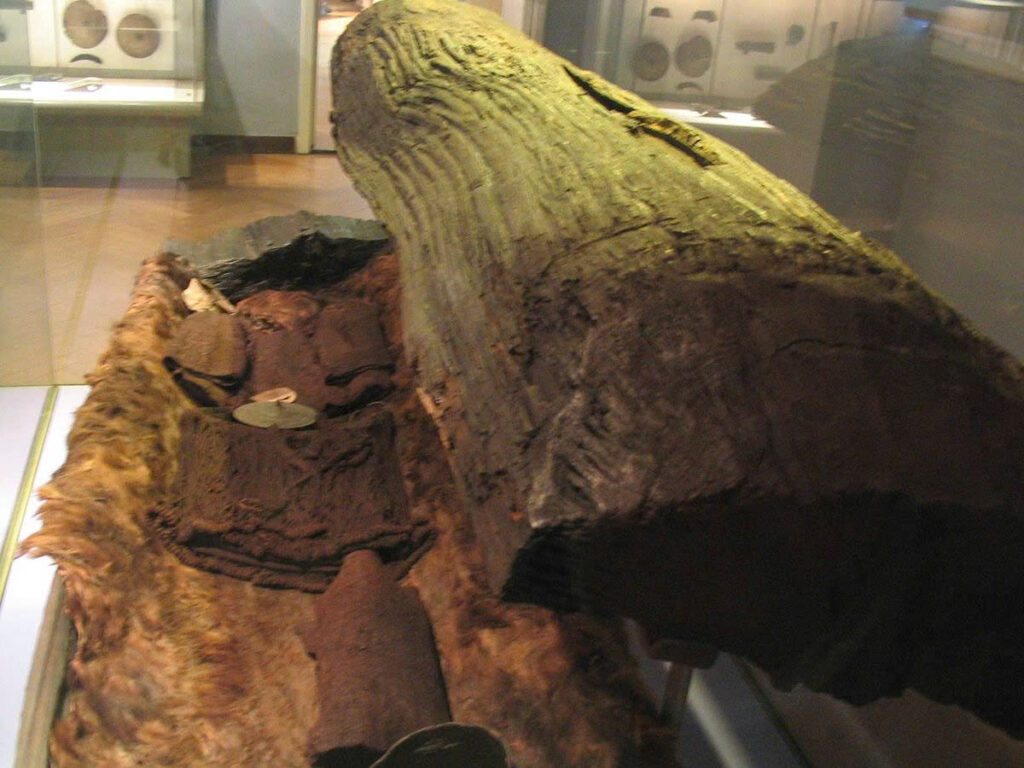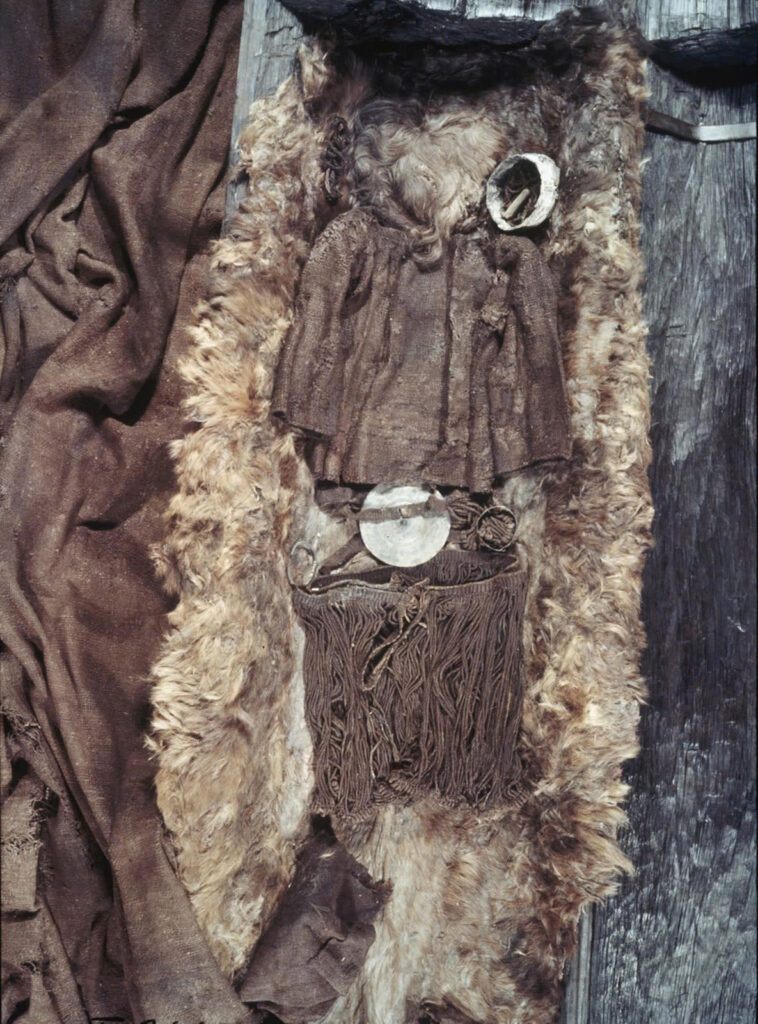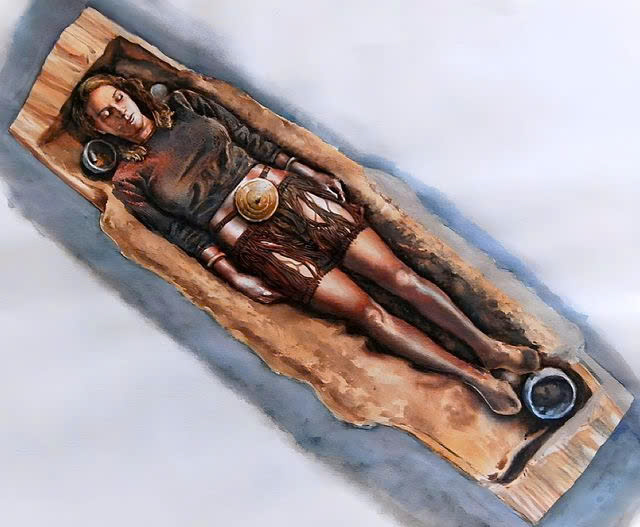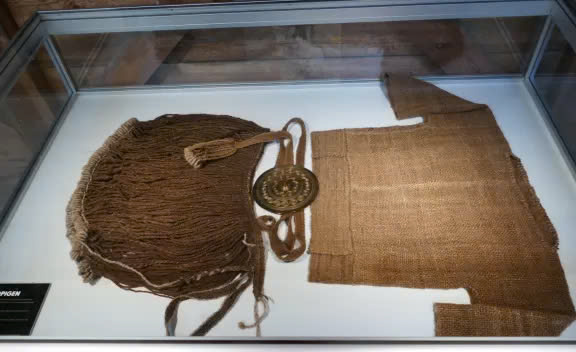In 1921, a routine excavation near the small Danish town of Egtved unexpectedly opened a window into life more than 3,400 years ago. Local farmers cutting into a peat bog unearthed an oak coffin—simple in appearance yet extraordinary in its preservation. Inside lay the remains of a teenage girl who would later be known as the Egtved Girl, one of the most iconic archaeological figures of the European Bronze Age.
Her burial revealed more than just a life cut short. It showcased a level of craftsmanship, mobility, and cultural expression that challenged long-held assumptions about prehistoric Europe. Today, the Egtved Girl is considered a symbol of the remarkable interconnectedness of ancient communities across the continent.
The Miraculous Preservation of a Bronze Age Burial

Peat bogs are more than natural landscapes; they act as accidental time capsules. The chemical composition of peat slows decomposition, especially for organic materials. While the Egtved Girl’s bones did not survive due to the acidic environment, other parts of her burial remained astonishingly intact.
When archaeologists opened the coffin, they discovered:
-
Her hair, neatly tied
-
Her fingernails, preserved in delicate detail
-
A wool skirt and blouse, still showing Bronze Age textile patterns
-
A belt disk of bronze, decorated with the spiral motifs associated with sun symbolism
-
Remnants of a cowhide cloak, originally placed over her body
-
A small box of cremated remains, likely from a child or younger relative
These preserved elements offered unprecedented insight into daily life, spiritual beliefs, and artistic expression during the Nordic Bronze Age. Few archaeological finds from this period have retained such a complete combination of clothing, personal objects, and soft tissue.
A Life That Began Far From Denmark

For nearly a century, it was assumed that the Egtved Girl had lived and died within Denmark. That assumption was overturned in 2015 when a team from the University of Copenhagen conducted strontium isotope analysis on her molars, hair, and nails—parts of the body that store geographic signatures from the environment.
The results were surprising:
She did not grow up in Denmark. Instead, the isotopic values pointed toward the Black Forest region of southern Germany, hundreds of kilometers to the south.
Even more fascinating, her hair and nails—reflecting the last several months of her life—suggested a pattern of long-distance movement. She had traveled back and forth between Denmark and central Europe in the months before her death. This challenges stereotypes of Bronze Age communities as isolated or immobile. Instead, it paints a picture of a continent where people, goods, and ideas flowed far more freely than once imagined.
Clothing That Revealed Culture, Status, and Belief

The Egtved Girl’s attire is one of the most recognizable Bronze Age outfits ever discovered.
She wore:
-
A short corded wool skirt, crafted through a sophisticated wrapping technique
-
A wool blouse, finely woven
-
A large bronze belt disk, decorated with concentric spirals and sun symbols
-
Two bronze arm rings
-
A delicate corded hair tie
This outfit was not simply functional. It expressed identity, status, and cultural affiliation. Scholars associate the spiral motifs with the Nordic sun cult, a belief system where the sun was revered as a cosmic force essential to life and fertility.
The style of her clothing, combined with the symbolism on her belt, suggests she may have participated in rituals connected to solar worship, a prominent feature of Bronze Age religion in Scandinavia.
Who Was She? Priestess, Diplomatic Bride, or Symbol of Alliance?

The question that fascinates researchers most remains unanswered: Who exactly was the Egtved Girl?
While we may never know her name, evidence allows several interpretations:
1. A Religious Figure
Her belt disk, attire, and burial position align with ritual practices associated with the sun cult. Similar symbols appear on rock carvings, gold artifacts, and ritual vessels across northern Europe.
2. A Diplomatic Bride
The Bronze Age was a period marked by complex alliances between regions. Families of high status often arranged marriages to forge ties, secure trade partnerships, or establish political cooperation. A girl traveling between southern Germany and Denmark could indicate such a political alliance.
3. A Member of a Mobile Elite
Across prehistoric Europe, certain groups maintained long-distance connections, exchanging metal, amber, cloth, and ritual knowledge. Her mobility fits this pattern of elite individuals moving across regions to sustain broad networks.
Whichever interpretation proves accurate, the Egtved Girl was undoubtedly significant within her community.
A Europe More Connected Than Imagined

The Egtved Girl’s transcontinental movements reveal that Bronze Age Europe was not a patchwork of isolated tribes. Instead, it was a network of cultures linked through:
-
Trade routes carrying tin, copper, amber, wool, and bronze goods
-
Shared religious symbolism, particularly in sun motifs
-
Inter-regional alliances and marriages, reinforcing political stability
-
Craft knowledge, transferred across thousands of kilometers
This was a world where people traveled for ritual duties, craftsmanship, diplomacy, and exchange. The Egtved Girl’s life shows that mobility and cultural interaction were central to Bronze Age identity.
Burial Traditions and Symbolic Meaning
Her coffin contained more than clothes and jewelry. It included:
-
A bundle of cremated bones, possibly from a younger sibling
-
A birch bark bucket with mead residue, indicating a burial feast
-
Cowhide lining, suggesting status and wealth
These items reflect complex funerary practices where life, death, and ritual merged. Cremation and inhumation were sometimes combined, hinting at beliefs about ancestry and transformation.
What Her Story Teaches Us About Bronze Age Society
The Egtved Girl is more than a single archaeological discovery; she is a key to understanding a world that was vibrant, mobile, and culturally interconnected.
Her story demonstrates:
1. Women Held Influential Roles
Whether religious, diplomatic, or political, women played crucial roles in shaping Bronze Age networks.
2. Trade and Craftsmanship Linked Regions
Her wool originated from southern Germany. Bronze objects in Denmark often used metal traded from central Europe. Cultural exchange was constant.
3. Spiritual Beliefs Spanned Northern Europe
Sun motifs, spirals, and ritual objects appear in Denmark, Germany, and beyond. Shared symbols implied shared cosmology.
4. Mobility Was Common
The idea that people rarely traveled long distances before modern times is false. The Egtved Girl’s life proves otherwise.
A Bronze Age Story That Still Evolves
More than a century after her discovery, the Egtved Girl continues to shape archaeological debate. New scientific techniques—from DNA analysis to isotope mapping—may one day reveal even more about her origins, her community, and her role within the world she inhabited.
What remains clear is that she was part of something larger: a landscape of movement, connection, belief, and innovation stretching across ancient Europe.
A Bridge Across 3,400 Years
The Egtved Girl stands today as a symbol of the Bronze Age’s sophistication. Her preserved clothing, her far-reaching travels, and the rituals surrounding her burial show a vibrant society deeply engaged with both local identity and continental exchange.
Her story reminds us that even in ancient times, people moved, traded, worshipped, and built alliances across vast distances. Far from being isolated, Bronze Age Europe was dynamic and interconnected—more than we ever imagined before she was found.
Sources
(Non-linked, AdSense-safe)
-
National Museum of Denmark – Research on Bronze Age burials
-
University of Copenhagen – Isotope analysis reports
-
European Journal of Archaeology – Studies on Bronze Age mobility
-
Archaeology Magazine – Features on prehistoric textile craftsmanship
-
Cambridge University Press – Bronze Age trade and ritual networks
